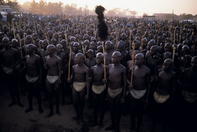
Ndebele Origins
In the 17th century, the Ndebele broke away from their coastal Nguni cousins, who were to become part of the mighty Zulu empire. Under the leadership of Musi, the Ndebele Tribe migrated inland, establishing themselves north of present-day Pretoria.
Musi is said to have been an astute ruler, whose first concern was the well-being of his subjects and their protection against exploitation by more powerful neighbours. Musi relied on diplomacy and not aggression to get his way.
As a just and respected ruler with a gentle disposition, he is thought to have gained the confidence of the Sotho peoples among whom he and his people settled.
The Tribe Divides
When Musi died, his eldest son, Manala, was named as the future chief. This was challenged by another senior son, Ndzundza, and the resulting squabble between the two divided the once united Ndebele. Eventually war became inevitable and, in a bloody struggle, Ndzundza was defeated and put to flight.He and his followers headed eastwards, settling in the upper part of the Steelpoort River basin at a place called KwaSimkhulu, near present-day Belfast, and Manala was installed as chief of his father's domain. However, it was not long before two other factions, led by other sons, broke away from the Ndebele core. The Kekana faction moved northwards and settled in the region of present-day Zebediela, and the other section, under Dlomo, returned to the east coast from where the Ndebele had originally come.